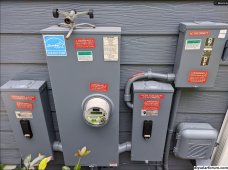For residential installs the 320/400 amp service is typically installed with 2 separate 200amp main panels fed by one meter, and loads are distributed across these 2 panels and because there are 2 separate 200 amp panels the total load can be up to the 320 amp maximum.
In your particular case you could have the circuits for the tank less water heater and the EV changer, along with any other loads that don't need backup in one of the main 200 amp panels. The other 200 amp panel, will be fed thru the 18kpv, and will contain the loads you want backed up. The CTs are used, if desired, to limit power be sent to the grid from your solar and batteries, **but still use your solar or battery for loads on non backed up panel, the one with the water heater and ev charger, when the grid is available. The CTs will be placed close to the meter and around the wires feeding both the inverter, and the other 200 amp panel**.



